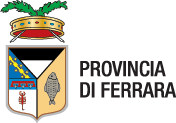Ferrara city of the 20th century
The itinerary starts from the 20th century Quadrilateral (Largo Antonioni), the main example of rationalist intervention. The four important buildings that overlook the square Largo Antonioni, together with Previati, De Pisis, Boldini and Mentessi streets which were part of the same urban planning project, contribute in defining its perimeter.
As customary in rationalist school of architecture, the complex was coinceived to concentrate the buildings devoted to the main socio-cultural missions of fascist regime, for the benefit of the citizens of Ferrara: music in the Girolamo Frescobaldi Conservatory and Auditorium, science in the former Institue of Natural History, now Natural History Museum, school in the Umberto I School, then renemed to Alda Costa, and leisure in the former meeting and cultural space of the Dopolavoro Provinciale Fascista – Fascist Provincial Recreational Association, currently the Boldini complex.
The itinerary ends in the square which hosts the majestic acqueduct, originally called Square XXVIII October to celebrate the march on Rome organised by the National Fascist Party in 1922.
1 Quadrivio di via Boldini, De Pisis, Mentessi, Previati
Largo Antonioni is the square that stands at the heart of the so called “Quadrilatero Novecentista” (“Twentieth-century Quadrilateral”) of Ferrara, also referred to as the “Quartiere razionalista” or “Quadrivio del Novecento” (“Rationalist Quarter” or “Twentieth-century Crossroads” respectively). As is customary in the rationalist school of architecture, the area was conceived to bring together the main socio-cultural focal points of the Fascist regime for the benefit of Ferrara’s citizens. It has been named after the famous film director as his city’s homage on the hundredth anniversary of his birth.
2 Complesso Boldini
C. Savonuzzi (1935-1939)
Construction of the Complesso Boldini building began on the site that was previously occupied by the westernmost part of Sant’Anna hospital men’s ward, founded in 1443 and expanded over the course of the following centuries. The remains of the hospital are still visible in the so-called “Grotte del Boldini”, the fifteenth-century cellars with groin-vaulted ceilings which can still be seen today, and are used for cultural initiatives.
3 Conservatorio di Musica “G. Frescobaldi”
C. Savonuzzi (1935-1937)
The complex was built using the pre-existing structures which belonged to the former Sant’Anna hospital. The large concert hall, designed to seat three hundred, was designed on the footprint of the former church of Sant’Anna; standing in the small square dedicated to the saint, the building retains the original façade with its open staircase and pronaos, where the cell of the poet Torquato Tasso has also been preserved.
4 Museo di Storia Naturale
C. Savonuzzi, 1935-1937
The main façade of the natural History Museum is composed of a grey stone gateway, which despite its simple style - typical of Twentieth century architecture - is in fact an echo of the classic composite portals, including the large entrance door which lies below a balcony which can be accessed from the large window above.
5 Scuola primaria statale “Alda Costa”
C. Savonuzzi (1932-1933)
The school, together with the other buildings that can be found in the socalled rationalist quarter, was built in the early 1930s, a result of the need to redevelop the area previously occupied by the city hospital. Originally christened in honour of the “re buono” (“good king”) Umberto I, after the Second World War it was renamed in order to pay homage to Alda Costa, the famous socialist leader and anti-Fascist teacher. The grooved tower, 37 metres tall, is a particularly characteristic feature of the building and serves as the end point of the perspective axis of Via Giovanni Boldini.
6 Palazzo delle Assicurazioni Generali
F. Forlati, A. Berlese (1925-1926)
The “Venetian” character that distinguishes this imposing building can be attributed to the client and architects, whose will led to place the lion of Venice - the symbol adopted by Assicurazioni Generali - between the building’s large entrance door and the corner balcony. The Vicenza limestone ashlar and neo-Palladian references characterise the façade, with windows that are almost Art Deco in style, and the wrought iron decorations on the internal staircase.
7 Torre della Vittoria
G. Savonuzzi, 1925-1928
The reconstruction of the tower was initiated at the behest of Italo Balbo, founder of the Fascist Party of Ferrara, on the site of the original tower which partially collapsed during the earthquake that struck the city in the 16th century. A public subscription was launched for its construction. The neo-Medieval style tower is 57 metres high and is crowned by a bell made by melting down the bronze from Austrian cannons. Supported by six eagles, it is decorated with the emblems of the Municipality and the local Fascist Party, with the commemorative inscription «Mentem sanctam, spontaneam Honorem Deo et Patriae liberationem» and images of the patron saints of Ferrara, Saint George and Saint Maurelius. In the lower part of the tower, there is a shrine dedicated to the citizens of Ferrara who died in First World War.
8 Camera di Commercio
S. Boari (1928-1929)
The Camera di Commercio (Chamber of Commerce) is located on the site that was previously occupied by the city’s first cinema, the Edison. It extends over two levels and the main entrance is further highlighted by four columns that support the first-floor balcony, while the door that opens onto it is embellished with sculpted figures, the symbolic representations of the Po and Reno rivers. The overall effect of the building makes clear reference to the architectural models of sixteenth-century classicism.
9 Ex Palazzo INA
G. Cipriani, F. Forlati, Machin (1934)
The exterior of the building showcases a harmonious combination of materials, which includes local stone bricks and the so-called “ceppo policromo” (coloured bricks) from the clay of Lake Iseo. Inside, the building is characterised by its functionality and comfort, as well as by its aesthetic appeal. Indeed, both from a functional and a decorative perspective, no detail has been overlooked in terms of choice of materials and forms.
10 Palazzo delle Poste
A. Mazzoni (1927-1929)
It is one of the most interesting buildings of twentieth-century Ferrara, despite the fact that on its inauguration, the design was condemned as being heavy handed, with little consideration of the local architectural and decorative traditions. An important hub within the city of Ferrara, the building is remarkable not only from an architectural perspective but also with regard to its decorative features, from the tall “Venetian-style” metal street lights which flank the main entrances to the two-tone tile flooring inside.
11 Ville liberty di Ciro Contini
Villa Melchiorri (1904)
This was the first of the residential villas to be built on the new Viale Cavour. It is characterised by its ornamental features, and in particular by the circle motif which dominates the entrance, accompanied by a similarly prominent floral motif.
Villa Amalia (1905)
This building is an expression of the eclectic aesthetic style that was typical of the “Umbertine” period. It is named after Amalia Torri, the wife of the man who commissioned it. Villa Amalia is notable for the refinement of its decorative elements, which can be attributed to the use of a combination of different materials, such as stucco, iron and ceramic.
Villa Masieri Finotti (1907-1908)
Commissioned by Teresa Masieri, the façade immediately reveals his allegiance to the Central European Jugendstil in its combination of different materials and phytomorphic decorative motifs.
12 Palazzo dell’Aeronautica
G. Gandini, 1935-1937
The Palazzo dell’Aeronautica (Aeronautics Building) is characterised by a strong rationalist influence, namely wanted by Italo Balbo, and is one of the most prominent structures in the Twentieth century renovation works implemented in Ferrara. The location of the main entrance to the Palazzo on the corner of the intersection between Viale Cavour and Via Ariosto is one of the most characteristic elements of the building; indeed, the entire building pivots around this rounded corner. The Palazzo is lacking in a single truly-representative façade, due to the fact that it was designed to be seen from the perspective of Viale Cavour, a bona fide showcase of modern Ferrara.
13 Ex Casa del Fascio
G. Gandini (1928-1930)
The Casa del Fascio (headquarters of the local Fascist party) was inaugurated on 23rd February 1931 in the presence of Italo Balbo, the Podestà (chief magistrate) Renzo Ravenna and high-level representatives of the various local authorities. The structure originally contained more than a hundred rooms and was 17 metres high; built around a courtyard, the building had a central body which was destined to be the main Fascist headquarters, along with two wings to the sides, reserved for the workers’ and farmers’ unions.
14 Scuola primaria statale “Mario Poledrelli”
G. Savonuzzi (1928)
Harmonious and somewhat severe in appearance, the building was created for use as a school, and has remained such over the years until today. The façade features clear references to the Ferrara tradition, both in terms of materials and form; indeed, the building can be described as being in the local hybrid style of the early twentieth century, referred to as “neo-estense”.
15 Acquedotto monumentale
C. Savonuzzi (1930-1932)
Similarly to the tower of “Alda Costa” school, the aqueduct is 37 metres high and, despite its size and the materials from which it is built, the structure retains a certain airiness and momentum, setting itself apart from other similar works from the same era that can be found across the country. It is completed by the fountain-statue entitled "Il Po e i suoi affluenti" (A. Minerbi), refering to one of the founding myths of the city and the surrounding region, namely that of Phaethon and Heliades, to which the poplars on either side of the fountain also refer.









